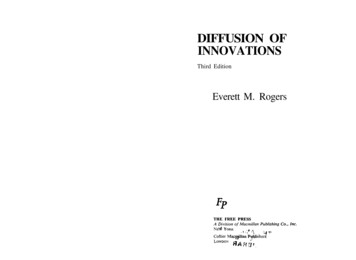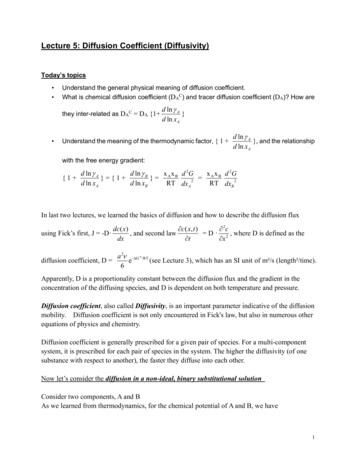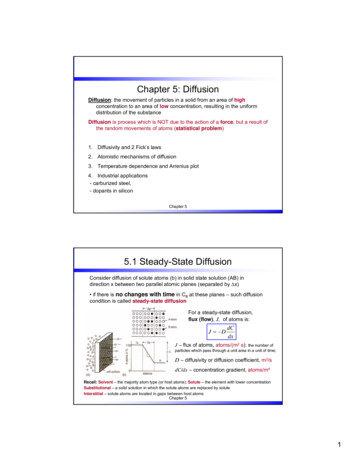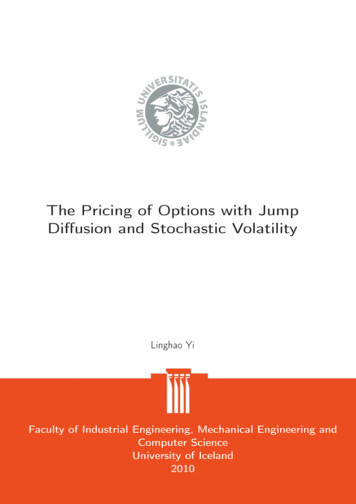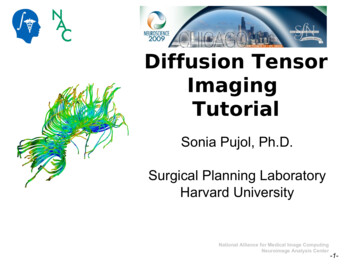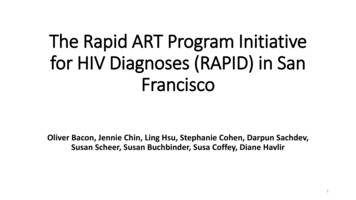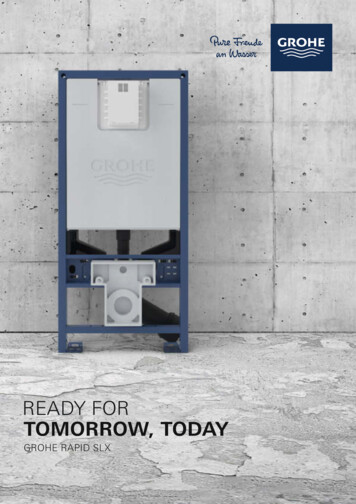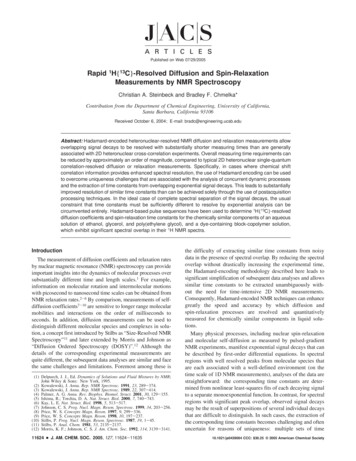
Transcription
Published on Web 07/29/2005Rapid 1H{13C}-Resolved Diffusion and Spin-RelaxationMeasurements by NMR SpectroscopyChristian A. Steinbeck and Bradley F. Chmelka*Contribution from the Department of Chemical Engineering, UniVersity of California,Santa Barbara, California 93106Received October 6, 2004; E-mail: bradc@engineering.ucsb.eduAbstract: Hadamard-encoded heteronuclear-resolved NMR diffusion and relaxation measurements allowoverlapping signal decays to be resolved with substantially shorter measuring times than are generallyassociated with 2D heteronuclear cross-correlation experiments. Overall measuring time requirements canbe reduced by approximately an order of magnitude, compared to typical 2D heteronuclear single-quantumcorrelation-resolved diffusion or relaxation measurements. Specifically, in cases where chemical shiftcorrelation information provides enhanced spectral resolution, the use of Hadamard encoding can be usedto overcome uniqueness challenges that are associated with the analysis of concurrent dynamic processesand the extraction of time constants from overlapping exponential signal decays. This leads to substantiallyimproved resolution of similar time constants than can be achieved solely through the use of postacquisitionprocessing techniques. In the ideal case of complete spectral separation of the signal decays, the usualconstraint that time constants must be sufficiently different to resolve by exponential analysis can becircumvented entirely. Hadamard-based pulse sequences have been used to determine 1H{13C}-resolveddiffusion coefficients and spin-relaxation time constants for the chemically similar components of an aqueoussolution of ethanol, glycerol, and poly(ethylene glycol), and a dye-containing block-copolymer solution,which exhibit significant spectral overlap in their 1H NMR spectra.IntroductionThe measurement of diffusion coefficients and relaxation ratesby nuclear magnetic resonance (NMR) spectroscopy can provideimportant insights into the dynamics of molecular processes oversubstantially different time and length scales.1 For example,information on molecular rotation and intermolecular motionswith picosecond to nanosecond time scales can be obtained fromNMR relaxation rates.2-6 By comparison, measurements of selfdiffusion coefficients7-10 are sensitive to longer range molecularmobilities and interactions on the order of milliseconds toseconds. In addition, diffusion measurements can be used todistinguish different molecular species and complexes in solution, a concept first introduced by Stilbs as “Size-Resolved NMRSpectroscopy”11 and later extended by Morris and Johnson as“Diffusion Ordered Spectroscopy (DOSY)”.12 Although thedetails of the corresponding experimental measurements arequite different, the subsequent data analyses are similar and facethe same challenges and limitations. Foremost among these is(1) Delpuech, J. J., Ed. Dynamics of Solutions and Fluid Mixtures by NMR;John Wiley & Sons: New York, 1995.(2) Kowalewski, J. Annu. Rep. NMR Spectrosc. 1991, 23, 289-374.(3) Kowalewski, J. Annu. Rep. NMR Spectrosc. 1989, 22, 307-414.(4) Palmer, A. G. Annu. ReV. Biophys. Biomol. Struct. 2001, 30, 129-155.(5) Ishima, R.; Torchia, D. A. Nat. Struct. Biol. 2000, 7, 740-743.(6) Kay, L. E. Nat. Struct. Biol. 1998, 5, 513-517.(7) Johnson, C. S. Prog. Nucl. Magn. Reson. Spectrosc. 1999, 34, 203-256.(8) Price, W. S. Concepts Magn. Reson. 1997, 9, 299-336.(9) Price, W. S. Concepts Magn. Reson. 1998, 10, 197-237.(10) Stilbs, P. Prog. Nucl. Magn. Reson. Spectrosc. 1987, 19, 1-45.(11) Stilbs, P. Anal. Chem. 1981, 53, 2135-2137.(12) Morris, K. F.; Johnson, C. S. J. Am. Chem. Soc. 1992, 114, 3139-3141.116249J. AM. CHEM. SOC. 2005, 127, 11624-11635the difficulty of extracting similar time constants from noisydata in the presence of spectral overlap. By reducing the spectraloverlap without drastically increasing the experimental time,the Hadamard-encoding methodology described here leads tosignificant simplification of subsequent data analyses and allowssimilar time constants to be extracted unambiguously without the need for time-intensive 2D NMR measurements.Consequently, Hadamard-encoded NMR techniques can enhancegreatly the speed and accuracy by which diffusion andspin-relaxation processes are resolved and quantitativelymeasured for chemically similar components in liquid solutions.Many physical processes, including nuclear spin-relaxationand molecular self-diffusion as measured by pulsed-gradientNMR experiments, manifest exponential signal decays that canbe described by first-order differential equations. In spectralregions with well resolved peaks from molecular species thatare each associated with a well-defined environment (on thetime scale of 1D NMR measurements), analyses of the data arestraightforward: the corresponding time constants are determined from nonlinear least-squares fits of each decaying signalto a separate monoexponential function. In contrast, for spectralregions with significant peak overlap, observed signal decaysmay be the result of superpositions of several individual decaysthat are difficult to distinguish. In such cases, the extraction ofthe corresponding time constants becomes challenging and oftenuncertain for reasons of uniqueness: multiple sets of time10.1021/ja0439064 CCC: 30.25 2005 American Chemical Society
Rapid NMR Diffusion and Spin Relaxation Measurementsconstants may exist, all of which may fit the decay data equallywell. This situation is made still more difficult when the numberof contributing components is also unknown. For example,Lanczos showed that a biexponential decay could be reproducedto within less than one percent by a sum of three exponentialswith significantly different time constants and initial amplitudes.13 These difficulties arise because exponential functionsare not orthogonal. As a consequence, the deviation of anumerical fit from the experimental data due to an incorrectfitting parameter can be compensated by the adjustment of oneor more other parameters. The problem is exacerbated as thenumber of components in the observed decay increases andbecomes even more complicated in the presence of experimentalnoise.14 For example, it has been shown that, for a twocomponent biexponential decay with a signal-to-noise ratio(SNR) of 103 (a value rarely exceeded in NMR measurements),the corresponding time constants need to differ by at least afactor of 2 to be reliably determined using a nonlinear leastsquares fit.15 By increasing the number of components to three,the required separation increases to a factor of 3.5. A reductionin the SNR to 102 further increases the required separation to afactor of 10 for a three-component decay. Consequently, theextraction of an often unknown number of time constants fromexperimental data is challenging, even for data sets exhibitinghigh signal-to-noise ratios.Much effort has therefore been focused on improvingpostacquisition data processing and on extending capabilitiesfor resolving different time constants from overlapping signals,while circumventing the need for precise knowledge of thenumber of components. A number of such processing approaches are described in an excellent review by Istratov andVyvenko16 to which the reader is referred for their detaileddiscussion and comparison. The selection of a preferred dataprocessing method depends on a number of factors, includingthe signal-to-noise level, the number of exponentially decayingcomponents, as well as the similarity of the time constants.Independent of the processing technique used, however, thereexist inherent uniqueness difficulties and limitations in thetemporal resolution achievable (i.e., the ratio of the timeconstants of two concurrent dynamic processes that can beresolved from a single multiexponential decay curve), whichdepend strongly on the signal-to-noise ratio of the measureddecay.In many cases, it is possible to improve temporal resolutionby resolving overlapping signals spectroscopically, for example,by incorporating additional chemical shift information frommultidimensional homonuclear or heteronuclear correlationexperiments. Such an approach can resolve, in two or morefrequency dimensions, NMR resonances that overlap in 1Dmeasurements. Separate signal decay curves can subsequentlybe obtained for each resolved resonance, and single-exponentialanalyses can be used to yield unambiguous values for thecorresponding time constants. In cases where the applicationof multidimensional experiments is not sufficient to resolvecompletely all overlapping resonances, the number of components associated with the observed signal decays may neverthe(13) Lanczos, C. Applied Analysis; Prentice Hall: Englewood Cliffs, NJ, 1959.(14) Bertero, M.; Boccacci, P.; Pike, E. R. Proc. R. Soc. London 1982, 383,15-29.(15) Clayden, N. J.; Hesler, B. D. J. Magn. Reson. 1992, 98, 271-282.(16) Istratov, A. A.; Vyvenko, O. F. ReV. Sci. Instrum. 1999, 70, 1233-1257.ARTICLESless be significantly reduced. Subsequent data processing canyield more reliable estimates of the time constants of interestthan possible from the poorly resolved decays associated withthe strongly overlapping signals obtained from 1D experiments.This approach has, for example, been used to determine theself-diffusivities17-21 of molecular species in solution mixturesof similar components with enhanced spectral and temporalresolution. However, the additional resolution obtained byrelying on multidimensional NMR methods comes with thedisadvantage of dramatically increased experimental measurement times. Depending on the resolution required in the indirectdimension, measuring times may increase 10- to 1000-fold,which in many cases makes such an approach infeasible. Thisis especially true for systems that undergo changes on the timescales of such long multidimensional experiments.Several experimental approaches have recently been demonstrated that allow faster acquisition of multidimensional NMRspectra. Frydman et al.,22,23 for example, used spatially selectiveNMR excitation and detection to separate a sample into a seriesof subensemble regions. Instead of incrementing the evolutiontime in a series of independent experiments, as typically donein 2D NMR spectroscopy, each of these subensembles couldthen be used to encode information for a different evolutiontime and a full 2D spectrum effectively acquired in a singlescan. Because of the small sample volume of each of thesesubensembles, this approach is especially useful for concentratedsamples.By comparison, Hadamard-encoded NMR spectroscopy24-37represents a conceptually different approach, which can be usefuleven for more dilute solutions. In Hadamard NMR, the evolutiontime in the indirect dimension is replaced by phase-encodedmultisite selective excitation, so that the experimental time iseffectively focused only on signal-containing spectral regions,instead of acquiring a complete spectrum in the indirectdimension. This approach has been used previously to investigate a number of dynamic processes. For example, the protondeuteron exchange kinetics in backbone amide groups in the(17) Buevich, A. V.; Baum, J. J. Am. Chem. Soc. 2002, 124, 7156-7162.(18) Williamson, R. T.; Chapin, E. L.; Carr, A. W.; Gilbert, J. R.; Graupner, P.R.; Lewer, P.; McKamey, P.; Carney, J. R.; Gerwick, W. H. Org. Lett.2000, 2, 289-292.(19) Parkinson, J. A.; Sun, H. Z.; Sadler, P. J. Chem. Commun. 1998, 881882.(20) Barjat, H.; Morris, G. A.; Swanson, A. G. J. Magn. Reson. 1998, 131,131-138.(21) Steinbeck, C. A.; Hedin, N.; Chmelka, B. F. Langmuir 2004, 20, 1039910412.(22) Frydman, L.; Lupulescu, A.; Scherf, T. J. Am. Chem. Soc. 2003, 125, 92049217.(23) Frydman, L.; Scherf, T.; Lupulescu, A. Proc. Natl. Acad. Sci. U.S.A. 2002,99, 15858-15862.(24) Blechta, V.; Freeman, R. Chem. Phys. Lett. 1993, 215, 341-346.(25) Freeman, R.; Kupce, E. J. Biomol. NMR 2003, 27, 101-113.(26) Krishnamurthy, K. J. Magn. Reson. 2001, 153, 144-150.(27) Nishida, T.; Widmalm, G.; Sandor, P. Magn. Reson. Chem. 1996, 34, 377382.(28) Nishida, T.; Widmalm, G.; Sandor, P. Magn. Reson. Chem. 1995, 33, 596599.(29) Schraml, J.; vanHalbeek, H.; DeBruyn, A.; Contreras, R.; Maras, M.;Herdewijn, P. Magn. Reson. Chem. 1997, 35, 883-888.(30) Van Melckebeke, N.; Simorre, J. P.; Brutscher, B. J. Am. Chem. Soc. 2004,126, 9584-9591.(31) vanHalbeek, H.; Schraml, J.; DeBruyn, A.; Contreras, R.; Maras, M.;Herdewijn, P. Glycobiology 1996, 6, 103-103.(32) Bougault, C.; Feng, L. M.; Glushka, J.; Kupce, E.; Prestegard, J. H. J.Biomol. NMR 2004, 28, 385-390.(33) Kupce, E.; Nishida, T.; Freeman, R. Prog. Nucl. Magn. Reson. Spectrosc.2003, 42, 95-122.(34) Kupce, E.; Freeman, R. J. Magn. Reson. 2003, 163, 56-63.(35) Kupce, E.; Freeman, R. J. Magn. Reson. 2003, 162, 300-310.(36) Kupce, E.; Freeman, R. J. Magn. Reson. 2003, 162, 158-165.(37) Kupce, E.; Freeman, R. J. Biomol. NMR 2003, 25, 349-354.J. AM. CHEM. SOC.9VOL. 127, NO. 33, 2005 11625
Steinbeck and ChmelkaARTICLESprotein ubiquitin have been probed by repeated acquisition ofHadamard-encoded 1H{15N} heteronuclear single-quantum correlation (HSQC) spectra.32 In this study, chemical rate processeswere quantified by monitoring reductions in 1H signal intensityafter diluting a fully protonated sample with D2O to produce asystem initially far from chemical equilibrium. Very recently,van Melckebeke et al. applied a Hadamard-encoded filter as areplacement for selective isotope labeling in 1H{13C} NOESYcross-relaxation experiments for the determination of methylmethyl distances in amino acids.30 The applicability of Hadamard encoding to heteronuclear-resolved relaxation measurements has also been suggested and proof-of-principle data havebeen reported in a recent review.33Here, the incorporation of Hadamard encoding into NMRdiffusion and spin-relaxation experiments is demonstrated toprovide spectroscopically resolved transient signal decays forspecies with strongly overlapping 1D signals. The principalobjectives are the unambiguous and rapid determination ofdiffusivities and relaxation times for a diverse range of complexsolutions. These include especially those with componentsundergoing dynamic processes that are characterized by verysimilar time constants. Hadamard methods are shown to serveas a general basis for modifying a large number of otherheteronuclear-resolved NMR experiments for the measurementof dynamic properties of complicated solution mixtures, including nonprotein systems and those in or far from chemicalequilibrium. Enhanced spectral and temporal resolution areachievable in substantially shorter times than correspondingmultidimensional experiments, while retaining the same information content. Measuring time requirements can be reducedby an order of magnitude, depending on the system underinvestigation, in this case an aqueous mixture of ethanol,glycerol, and poly(ethylene glycol) or a dye-containing blockcopolymer solution. This allows for significantly more accurateand time-efficient determination of even very similar timeconstants associated with dynamic processes (e.g., self-diffusioncoefficients or spin-relaxation times) in complicated solutionmixtures than previously possible.Theory and BackgroundThe investigation of dynamic processes by NMR typicallyinvolves three steps: the preparation of an initial magnetizationstate, followed by a transient decay period, and subsequentdetection of the resulting signal. During the preparation period,a specific and well-defined magnetization state is created by aseries of radio frequency and possibly gradient pulses. Theintensity of this state, I0, serves as the initial intensity, afterwhich the signal may become attenuated during the subsequentdecay period. For diffusion measurements, the signal attenuationresults from incomplete refocusing of magnetization at the endof the decay period.8,38 In a typical stimulated-echo experiment,9,39 the strength g of the applied gradient is varied and,from the resulting intensity decay (signal intensity as a functionof the square of the gradient strength), the mean molecular selfdiffusion coefficient can be determined by a monoexponentialanalysis. In such a case(38) Stejskal, E. O.; Tanner, J. E. J. Chem. Phys. 1965, 42, 288-292.(39) Tanner, J. E. J. Chem. Phys. 1970, 52, 2523-2526.11626 J. AM. CHEM. SOC.9VOL. 127, NO. 33, 20052 2 2I) exp[-γ g δ ( - δ/3)D]/I0(3)where I is the observed signal intensity of the refocused echo,I/0 is the maximum signal intensity observed in the absence ofthe gradient pulses (including spin-relaxation losses), γ is thegyromagnetic ratio of the nucleus under investigation, g is thestrength of the applied gradient pulse, δ is the duration of thegradient pulse, is the diffusion time, and D is the self-diffusioncoefficient. If signals overlap, the determination of diffusioncoefficients from experimental data suffers from the generallimitations associated with the exponential analyses discussedabove.For measurements of spin-relaxation times, by comparison,the signal attenuation during the decay period results not fromincomplete refocusing in the presence of field gradients butrather from nuclear spin-relaxation processes. Typically, theseare divided into two classes: longitudinal spin-lattice relaxation(T1), which characterizes the return of the z-magnetizationcomponent in the direction of the applied field to thermalequilibrium, and transverse spin-spin relaxation (T2), whichcharacterizes the loss of phase coherence of magnetization inthe xy plane normal to the applied field. Both of these processescan also be treated by monoexponential analyses:40I) -a b exp(-τ/Ti)I0(4)where I is the measured signal intensity, I0 is the initial signalintensity measured in the absence of a decay period, a and bare constants that depend on the experiment being performed(e.g., a ) -1, b ) 2 for an inversion recovery experiment40),τ is the duration of the decay period during which spin relaxationis allowed to occur, and Ti is the spin-relaxation time constant(e.g., T1 for an inversion recovery experiment). In a typical seriesof experiments, the duration of the decay time, τ, is varied,yielding an exponential decay in the measured signal intensityfrom which the relaxation time constant, Ti, is determined. Inthe presence of overlapping signals, such an analysis suffersfrom the aforementioned difficulties of uniquely extractingdifferent time constants from the resulting signal decays, whichare analogous to those previously described for the determinationof diffusion coefficients.As introduced above, one solution to the problem of overlapping signals is to modify the detection period to incorporate amultidimensional heteronuclear segment in order to spread andcorrelate NMR frequencies in more than one spectral dimension.For example, a 1H{13C} HSQC experiment correlates signalsfrom 13C moieties with directly bonded (J-coupled) protons,yielding 2D spectra in which correlated signal intensity isobserved at the corresponding 13C and 1H chemical shifts. It ispossible to circumvent the long measuring time requirementsassociated with such multidimensional correlation experimentsby concentrating on those spectral regions that contain resonancesignals. This is achieved by replacing the evolution time of a2D experiment with pulses that selectively excite the resonancesof interest. Multidimensional NMR techniques, however, alsobenefit from multiplexing; i.e., each time-domain data point that(40) Abragam, A. The Principles of Nuclear Magnetic Resonance; ClarendonPress: Oxford, 1961.
Rapid NMR Diffusion and Spin Relaxation MeasurementsARTICLESFigure 1. Phase-encoding and signal-filtering summaries of Hadamard-encoded NMR spectroscopy for an arbitrary sample containing four distinctly resolvedresonances. (a) During signal acquisition the various resonances are selectively phase-encoded (positive or negative), according to the matrix shown. For thecase of four different resonances, the experiment is repeated four times (Exp 1, 2, 3, and 4) with varying phase encoding. (b) During processing, the signalscorresponding to each of the four resonances are separated by addition or subtraction of the free-induction decays obtained in each of the four experiments.The elements outlined in bold are discussed specifically in the text.is collected in the indirect dimension contains information abouteach point in the frequency domain. To regain this multiplexingbenefit, it is necessary to irradiate a sample at several differentfrequencies simultaneously (multiplexing) and later extract theindividual contributions from the observed signal. As firstdemonstrated by Golay41 in infrared spectroscopy, it is possibleto use Hadamard encoding and decoding to achieve theseparation of the individual signal contributions. The introduction of Fourier transform NMR42 (FT-NMR), which is inherentlya multiplexing technique, superseded efforts by Anderson43 toachieve similar sensitivity advantages in NMR. In many cases,and especially in multidimensional NMR, the use of selectiveexcitation and Hadamard encoding (as opposed to the broadbandexcitation used in FT-NMR) can however be beneficial, asillustrated in a recent comprehensive review by Kupce et al.33By applying the Hadamard methodology, filtered NMRspectra can be obtained by judicious processing (addition andsubtraction) of the free-induction decays (FIDs) correspondingto a sufficient number of experiments. In general, 4m suchexperiments are required, where m is chosen such that 4m isthe smallest multiple of 4 that is greater than or equal to thenumber of signals to be resolved.24,34,44,45 For example, fourseparate Hadamard experiments must be performed with different phase encodings for a system containing four distinctresonances in order to obtain selectively filtered spectra for eachof the individual resonances. The appropriate phase encodingsand postacquisition processing are illustrated schematically inFigure 1a and b, respectively. For example, the signal corresponding to the third resonance would be phase-encoded [Figure1a, outlined in bold] to be positive in the first and secondexperiments and negative in the third and fourth experiments.As depicted in the bolded box of Figure 1b, a correspondingfiltered spectrum would then be obtained by adding togetherthe phase-encoded FIDs acquired in experiments 1 and 2 andsubtracting those acquired in experiments 3 and 4. Thiscombination of additions and subtractions, leads to a filtered1D NMR spectrum in which the signal intensity of the thirdresonance is four times that obtained in each individualexperiment, while the contributions from the remaining resonances have been canceled. Different, but analogous, additionand subtraction combinations of the same Hadamard-phase(41) Golay, M. J. E. J. Opt. Soc. Am. 1949, 39, 437-444.(42) Ernst, R. R.; Anderson, W. A. ReV. Sci. Instrum. 1965, 36, 1696-1706.(43) Anderson, W. A. In Encyclopedia of Nuclear Magnetic Resonance; Grant,D. M., Harris, R. K., Eds.; Wiley: Chichester, UK; 1996; Vol. 1, pp 168176.(44) van Lint, J. H.; Wilson, R. M. A Course in Combinatorics; CambridgeUniversity Press: New York, 1993.(45) This is strictly true only up to a maximum matrix size of 428 428,44 butin practice the use of Hadamard encoding is not efficient for such a largenumber of resonances. In addition Hadamard matrices of size 2 2 alsoexist.encoded FIDs can be used to obtain filtered spectra for each ofthe remaining resonances, as similarly indicated in Figure 1b.By implementing a Hadamard-encoded heteronuclear componentin the detection period of self-diffusion and spin-relaxationexperiments, it is possible to separate signals that overlap whenusing a conventional 1D detection scheme. This has the benefitof significantly improving the temporal resolution of similartime constants, while avoiding the long experimental times of2D measurements.Experimental SectionEthanol [CH3CH2OH], glycerol [HOCH2-CHOH-CH2OH], poly(ethylene glycol) [(-OCH2CH2-)n with naverage ) 80], and D2O wereused as received from Sigma-Aldrich (St. Louis, MO). Two solutionstate samples were used in the first part of this study: (1) 10 wt %glycerol in D2O and (2) 5 wt % ethanol, 10 wt % glycerol, and 2 wt% poly(ethylene glycol) in D2O. A 400 µL aliquot of each sample wasplaced in separate 5 mm NMR tubes and analyzed using a BrukerAVANCE 500 spectrometer operating at 500.13 MHz for 1H and 125.76MHz for 13C at room temperature (298 K, calibrated using methanol).Experiments were performed using a triple-axis gradient probehead withmaximum gradient strengths of 6.65 G/mm in the z-direction and 5.01G/mm in the x- and y-directions (calibrated using the diffusioncoefficient of water at 298 K).Gradient-selected 2D 1H{13C} HSQC experiments46,47 consisted of2 scans for each of 128 data points in the indirectly detected 13Cdimension and 8096 data points in the directly detected 1H dimension.Globally optimized alternating-phase rectangular-pulse (GARP)48 13Cdecoupling was applied with a field strength of 3 kHz during signalacquisition. The corresponding Hadamard-encoded experiments consisted of 4 scans for each of the 8 experiments necessary to resolve thefive 1H{13C} resonances considered here, i.e., the -CH2OH and -CH3resonances of ethanol, the -CH2OH and -CHOH- resonances ofglycerol, and the -OCH2CH2- resonances of poly(ethylene glycol).The selective inversion pulses were shifted laminar pulses49 withGaussian shapes and pulse lengths of 7 ms. Forward and reverse INEPTmagnetization transfer periods, d, were used, corresponding to 1/(4JCH)with JCH ) 145 Hz.50 GARP 13C decoupling with a field strength of 3kHz was applied for approximately 1.3 s during the acquisition periodof the Hadamard-encoded experiments. In addition, WALTZ-16 1Hdecoupling51 was applied with a field strength of 6 kHz during theselective 13C pulses of the Hadamard sequences. To maintain theexisting longitudinal spin order after selective inversion, the duration(46) Willker, W.; Leibfritz, D.; Kerssebaum, R.; Bermel, W. Magn. Reson. Chem.1993, 31, 287-292.(47) Vuister, G. W.; Boelens, R.; Kaptein, R.; Hurd, R. E.; John, B.; van Zijl,P. C. M. J. Am. Chem. Soc. 1991, 113, 9688-9690.(48) Shaka, A. J.; Barker, P. B.; Freeman, R. J. Magn. Reson. 1985, 64, 547552.(49) Shifted laminar pulses are essentially linear superpositions of individualselective pulses in which the frequency offset of the individual pulses isachieved through phase modulation.(50) An average value was used for the J-coupling, resulting in efficientmagnetization transfer for all of the proton-carbon pairs investigated.(51) Shaka, A. J.; Keeler, J.; Frenkiel, T.; Freeman, R. J. Magn. Reson. 1983,52, 335-338.J. AM. CHEM. SOC.9VOL. 127, NO. 33, 2005 11627
Steinbeck and ChmelkaARTICLESFigure 2. Schematic diagrams of pulse sequences for (a) a Hadamard-encoded gradient-selected heteronuclear single-quantum correlation (Ha-HSQC)experiment and (b) a pulsed-gradient double-stimulated-echo experiment with Ha-HSQC detection (Ha-PG-DSTE). Wider and narrower pulse features correspondto π and π/2 pulses, respectively, labeled boxes correspond to decoupling periods, and Gaussian shapes indicate shifted laminar selective pulses used forHadamard encoding. The bottom-most line in each pulse program corresponds to the gradient channel. The diffusion time in the PG-DSTE sequences isabbreviated as , and the transfer time in the INEPT blocks is abbreviated as d and set to 1/(4JCH). The selective laminar 13C pulse and the WALTZ 1Hdecoupling are centered between the preceding 1H and the subsequent 13C π/2 pulses. The delay 2d ′ was chosen to be just long enough to include theselective pulse and the spoil gradient g1 (including a gradient recovery delay), while ensuring that an integer number of WALTZ-16 cycles was carried out.For the Ha-PG-DSTE experiment, the delay t was chosen to accommodate the diffusion gradients (including a gradient recovery delay), and the eddy currentdelay t ′ was kept short (10 ms) to minimize relaxation losses. All phases are x unless otherwise specified. The following phase cycles were employed: (a)Ha-HSQC: φ1 ) (x)2, (-x)2; φ2 ) x, -x; φrec ) x, -x, -x, x; (b) Ha-PG-DSTE: φ1 ) (x)4, (-x)4; φ2 ) x, -x; φ3 ) (-x)2, (x)2; φrec ) x, -x, -x, x, -x,x, x, -x. The following gradient strengths were used in the different experiments: (a) Ha-HSQC: spoil gradient g1 ) 1.25 ms at 4.35 G/mm, encodinggradient g2 ) 1.00 ms at 6.52 G/mm, decoding gradient g3 ) 1.00 ms at 1.63 G/mm (g2/g3 ) 4:1). (b) Ha-PG-DSTE: g1, g2, g3 as for Ha-HSQC, diffusiongradient g4 ) 2.5 ms with varying gradient strength, spoil gradient g5 ) 1.0 ms at 0.65 G/mm, spoil gradient g6 ) 1.0 ms at 0.75 G/mm, and spoil gradientg7 at 1.05 G/mm.of the 1H decoupling period was chosen such that it contained onlycomplete WALTZ-16 cycles.Pulsed-gradient stimulated-echo diffusion experiments were performed using a diffusion time, , of 200 ms with encoding and decodinggradients in the z-direction of duration δ ) 2.5 ms and gradient strengthsvarying from 0.13 G/mm to 6.32 G/mm. All experimentally observeddiffusion coefficients were normalized to the diffusion coefficient ofwater, which was determined from the proton resonance associated withresidual non-perdeuterated water (HDO, H2O). Heteronuclear-resolved13C T relaxation times were measured by using a pulse sequence1proposed by Jin et al.52 In this pulse sequence, a sandwich of four π/2pulses and four gradient pulses is repeated during the relaxation timeto remove the effects of cross-correlations. For these 13C T1 measurements, the relaxation times were varied between 200 ms and 10 s with1H π pulses applied every 10 ms. Recycle delays (10 s) were usedbetween successive scans. For the directly excited/detected 13Crelaxation measurements, WALTZ-16 1H decoupling with a fieldstrength of 6 kHz was applied during signal acquisition. In validatingthe applicability of the Hadamard-encoded HSQC-resolved 1
Measurements by NMR Spectroscopy Christian A. Steinbeck and Bradley F. Chmelka* Contribution from the Department of Chemical Engineering, UniVersity of California, Santa Barbara, California 93106 Received October 6, 2004; E-mail: bradc@engineering.ucsb.edu Abstract:Hadamard-encoded heteronuclear-resolved NMR diffusion and relaxation .

